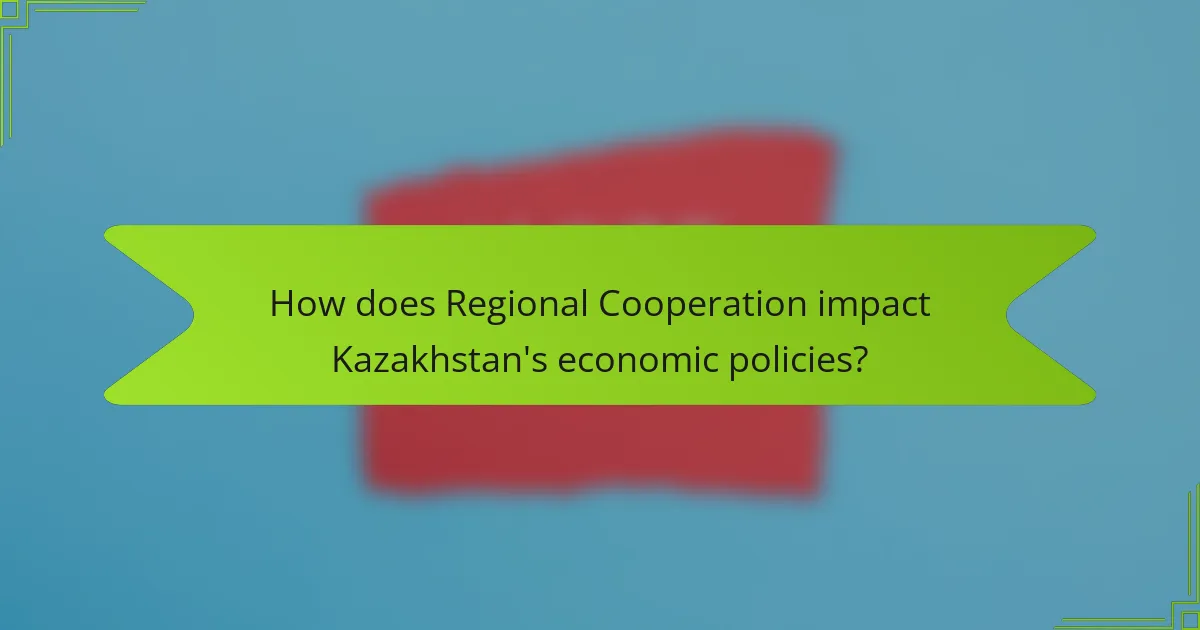Kazakhstan’s economic policies are centered on diversification and modernization, with a focus on reducing reliance on the oil and gas sectors. The government promotes growth in agriculture, manufacturing, and services through the “Kazakhstan-2050” strategy, which emphasizes innovation and sustainable development. Key initiatives include attracting foreign direct investment (FDI) via investment incentives and the establishment of Special Economic Zones (SEZs). Additionally, regional cooperation through frameworks like the Eurasian Economic Union enhances trade partnerships and market access, contributing to overall economic growth and stability. The article evaluates these strategies, the investment climate, and the impact of regional cooperation on Kazakhstan’s economic landscape.

What are the Economic Policies of Kazakhstan?
Kazakhstan’s economic policies focus on diversification and modernization. The government aims to reduce reliance on oil and gas sectors. It promotes sectors such as agriculture, manufacturing, and services. Kazakhstan has implemented the “Kazakhstan-2050” strategy for long-term development. This strategy emphasizes innovation and sustainable growth. Investment incentives are provided to attract foreign direct investment. Special Economic Zones (SEZs) have been established to foster business development. The National Fund of the Republic of Kazakhstan supports economic stability and investment projects. These policies aim to enhance the country’s competitiveness in the global market.
How have Kazakhstan’s economic policies evolved over time?
Kazakhstan’s economic policies have evolved significantly since its independence in 1991. Initially, the country adopted a command economy model inherited from the Soviet Union. This included state control over most industries and resources. In the late 1990s, Kazakhstan shifted towards market-oriented reforms. These reforms aimed to attract foreign investment and privatize state-owned enterprises. The government implemented the Strategy for Industrial and Innovative Development in 2003. This strategy focused on diversifying the economy beyond oil and gas.
By the 2010s, Kazakhstan’s policies emphasized regional cooperation and integration. The country joined the Eurasian Economic Union in 2015 to enhance trade relations. Recent policies have focused on digital transformation and sustainable development. The government launched the Digital Kazakhstan program in 2017 to modernize various sectors. Overall, Kazakhstan’s economic policies have transitioned from a centralized approach to a more market-driven and diversified strategy.
What historical factors have influenced these policies?
Kazakhstan’s economic policies have been significantly influenced by its historical context. The Soviet Union’s centralized planning shaped the early economic framework post-independence. The transition to a market economy in the 1990s necessitated reforms to attract foreign investment. The 2008 global financial crisis prompted a reevaluation of economic strategies. Additionally, Kazakhstan’s rich natural resources have driven policies focused on resource management and export diversification. Historical ties with neighboring countries have also influenced regional cooperation strategies. These factors collectively define the current economic landscape and policy direction in Kazakhstan.
How do these policies align with global economic trends?
Kazakhstan’s economic policies align with global economic trends by focusing on diversification and sustainability. These policies aim to reduce reliance on oil and gas revenues. This shift reflects a broader global trend towards sustainable economic practices. Kazakhstan’s emphasis on green technology and renewable energy mirrors international commitments to combat climate change. The country’s initiatives in digital transformation align with the global digital economy’s expansion. Additionally, Kazakhstan’s efforts to attract foreign investment are consistent with worldwide trends of increasing cross-border capital flows. These strategies are supported by global economic frameworks that prioritize innovation and competitiveness. Therefore, Kazakhstan’s policies resonate with the evolving landscape of global economic practices.
What are the primary goals of Kazakhstan’s economic policies?
The primary goals of Kazakhstan’s economic policies are to foster sustainable economic growth and enhance the investment climate. Kazakhstan aims to diversify its economy beyond oil and gas dependency. This includes promoting sectors like agriculture, manufacturing, and services. Another goal is to improve the business environment to attract foreign investment. The government seeks to implement reforms that streamline regulations and reduce bureaucracy. Additionally, enhancing regional cooperation is a priority to boost trade and economic integration with neighboring countries. These goals align with the nation’s long-term development strategy, known as “Kazakhstan 2050.”
How do these goals aim to promote economic growth?
These goals aim to promote economic growth by enhancing investment opportunities and fostering innovation. By creating a favorable investment climate, the government encourages both domestic and foreign investments. Increased investments lead to the development of infrastructure and industries, which generate jobs.
Job creation boosts consumer spending, further stimulating economic activity. The goals also focus on improving regional cooperation, which opens new markets for businesses. Access to broader markets increases trade and economic exchanges.
These strategies are supported by data showing that countries with strong investment climates experience higher GDP growth rates. For instance, Kazakhstan’s GDP growth was projected at 4.5% in 2023, reflecting the positive impact of these economic policies.
What role does diversification play in these policies?
Diversification plays a crucial role in the economic policies of Kazakhstan. It aims to reduce reliance on oil and gas sectors. By promoting various industries, the country seeks sustainable economic growth. This strategy mitigates risks associated with fluctuating global oil prices. Diversification also enhances job creation across different sectors. Furthermore, it attracts foreign investment by showcasing a broader economic base. The government has initiated programs to support sectors like agriculture and technology. Evidence of success includes increased GDP contributions from non-oil industries. Overall, diversification strengthens Kazakhstan’s economic resilience and stability.

What Growth Strategies are Implemented in Kazakhstan?
Kazakhstan implements several growth strategies to enhance its economy. One primary strategy is diversification away from oil dependency. The government aims to develop sectors like agriculture, manufacturing, and services. Another strategy focuses on attracting foreign direct investment (FDI). Initiatives such as the Astana International Financial Centre are designed to create a favorable investment climate. Additionally, Kazakhstan emphasizes infrastructure development. Projects include modernizing transport networks and improving logistics. The country also invests in human capital through education reforms. This aims to equip the workforce with necessary skills. Lastly, Kazakhstan fosters regional cooperation through initiatives like the Eurasian Economic Union. These strategies collectively aim to achieve sustainable economic growth.
How does Kazakhstan plan to stimulate economic growth?
Kazakhstan plans to stimulate economic growth through diversification, investment in infrastructure, and enhancing the business environment. The government aims to reduce reliance on oil and gas by promoting sectors like agriculture and manufacturing. Significant investments in infrastructure projects are set to improve connectivity and logistics. Additionally, reforms are being implemented to simplify regulations for businesses. These measures are expected to attract foreign investment and foster entrepreneurship. The government’s initiatives align with the Kazakhstan 2050 Strategy, targeting sustainable development and economic resilience.
What specific sectors are targeted for growth?
The specific sectors targeted for growth in Kazakhstan include agriculture, renewable energy, and information technology. The government emphasizes agriculture to enhance food security and export potential. Renewable energy is prioritized to diversify energy sources and reduce carbon emissions. Information technology aims to boost innovation and digital transformation. These sectors align with Kazakhstan’s economic diversification goals. The strategy is supported by investments and infrastructure development initiatives.
How does the government support entrepreneurship and innovation?
The government of Kazakhstan supports entrepreneurship and innovation through various initiatives and programs. It provides financial assistance, including grants and low-interest loans, to startups and small businesses. The government has established special economic zones that offer tax incentives and infrastructure support. It also facilitates access to markets through trade agreements and export promotion programs. Additionally, the government invests in research and development to foster innovation. Programs aimed at enhancing entrepreneurial skills and education are also available. These efforts aim to create a favorable environment for business growth and technological advancement.
What are the key challenges facing growth strategies?
Key challenges facing growth strategies include market volatility, regulatory hurdles, and resource limitations. Market volatility can disrupt investment plans and affect consumer confidence. Regulatory hurdles often impede business operations and slow down decision-making processes. Resource limitations, such as skilled labor shortages, can restrict the implementation of growth initiatives. Additionally, geopolitical factors may influence economic stability and investment attractiveness. These challenges require strategic planning and adaptability to navigate effectively.
How does the political environment affect these strategies?
The political environment significantly influences the economic strategies in Kazakhstan. A stable political climate fosters investor confidence and encourages foreign direct investment. Conversely, political instability can deter investment and slow economic growth. For instance, the government’s commitment to reforms and transparency impacts the attractiveness of the investment climate. Policies that promote regional cooperation can enhance trade relationships and economic partnerships. Historical context shows that Kazakhstan’s political decisions directly correlate with economic performance indicators. In 2020, the World Bank noted that political stability improved economic growth rates in the region. Thus, the political environment is a crucial determinant of the effectiveness of economic strategies in Kazakhstan.
What external factors pose risks to economic growth?
External factors that pose risks to economic growth include global economic conditions, geopolitical tensions, and fluctuations in commodity prices. Global economic conditions can lead to reduced demand for exports. For instance, a slowdown in major economies like China can directly impact Kazakhstan’s trade. Geopolitical tensions, especially in neighboring regions, can disrupt trade routes and investment flows. Fluctuations in commodity prices, particularly oil and gas, significantly affect Kazakhstan’s revenue. As a resource-dependent economy, lower prices can lead to budget deficits. These external factors create uncertainties that can hinder sustained economic growth.

How does the Investment Climate in Kazakhstan affect its economy?
The investment climate in Kazakhstan significantly influences its economy. A favorable investment climate attracts foreign direct investment (FDI). In 2022, Kazakhstan received approximately $24 billion in FDI, which boosted economic growth. The government has implemented reforms to enhance the business environment. These reforms include tax incentives and streamlined regulations. Improved infrastructure also supports investment activities. For example, the Astana International Financial Centre promotes financial services. Additionally, a stable political environment fosters investor confidence. Overall, a strong investment climate contributes to job creation and economic diversification in Kazakhstan.
What measures have been taken to improve the investment climate?
Kazakhstan has implemented several measures to improve its investment climate. These include the establishment of the Astana International Financial Centre, which offers tax incentives and a regulatory framework favorable for investors. Additionally, the government has streamlined business registration processes, reducing the time required to start a business significantly. Kazakhstan has also introduced various investment protection agreements to safeguard foreign investments. Furthermore, the country has enhanced its infrastructure, including transportation and logistics, to facilitate trade. These initiatives have contributed to a more attractive environment for both domestic and foreign investors.
How do these measures enhance foreign direct investment?
These measures enhance foreign direct investment (FDI) by creating a more favorable business environment. Improved regulatory frameworks reduce barriers to entry for foreign companies. Enhanced infrastructure supports efficient operations and logistics for investors. Tax incentives attract international businesses seeking cost-effective opportunities. Political stability reassures investors about the safety of their capital. Transparent legal systems protect foreign investments and intellectual property rights. Kazakhstan’s strategic location offers access to key markets in Asia and Europe. Collectively, these factors contribute to increased investor confidence and higher FDI inflows.
What incentives are offered to attract investors?
Kazakhstan offers various incentives to attract investors. These include tax holidays, reduced tax rates, and exemptions on customs duties. Investors can benefit from government grants and subsidies for specific projects. Special Economic Zones (SEZs) provide additional advantages such as simplified administrative procedures. The country also ensures protection of foreign investments through legal guarantees. Kazakhstan’s strategic location offers access to large markets in Asia and Europe. These incentives aim to create a favorable investment climate and stimulate economic growth.
What are the perceptions of investors regarding Kazakhstan?
Investors generally perceive Kazakhstan as a country with significant potential for growth. The nation benefits from abundant natural resources, particularly in oil and gas. Kazakhstan’s strategic location between Europe and Asia enhances its appeal for trade and investment. The government has implemented various reforms to improve the business climate. These reforms include tax incentives and regulatory simplifications. However, concerns about political stability and corruption persist among investors. Transparency International’s Corruption Perceptions Index ranks Kazakhstan lower than many neighboring countries. Despite these challenges, many investors remain optimistic about long-term opportunities in various sectors.
How does investor confidence influence economic policies?
Investor confidence significantly influences economic policies by shaping government decisions on fiscal and monetary strategies. High investor confidence typically leads to increased capital inflows. This encourages governments to adopt pro-business policies, such as tax incentives or infrastructure investments. Conversely, low investor confidence can result in cautious economic policies or austerity measures. Historical data shows that during periods of high confidence, countries often experience robust economic growth. For instance, Kazakhstan has seen policy shifts favoring foreign investment when confidence levels rise. This correlation highlights the critical role of investor sentiment in determining the direction of economic policies.
What feedback do investors provide on regulatory frameworks?
Investors provide feedback on regulatory frameworks by highlighting their need for clarity and consistency. They emphasize that clear regulations foster a stable investment environment. Investors often express concerns about bureaucratic hurdles and lengthy approval processes. They seek streamlined procedures to enhance efficiency. Furthermore, investors appreciate transparent communication from regulatory bodies. They believe that better engagement can build trust and improve compliance. Feedback also indicates a demand for regulations that adapt to market changes. Investors advocate for policies that encourage innovation and competition. Overall, constructive feedback from investors can guide improvements in regulatory frameworks.

How does Regional Cooperation impact Kazakhstan’s economic policies?
Regional cooperation significantly influences Kazakhstan’s economic policies. It fosters trade partnerships and enhances economic integration with neighboring countries. This cooperation leads to improved access to markets, which stimulates economic growth. For instance, Kazakhstan’s participation in the Eurasian Economic Union promotes tariff reductions and streamlined customs procedures. Such measures encourage foreign investment and attract businesses to the region. Additionally, regional cooperation facilitates shared infrastructure projects, such as transportation and energy networks. These projects are vital for enhancing connectivity and economic efficiency. Overall, regional cooperation shapes Kazakhstan’s economic policies by promoting collaboration, trade, and investment opportunities.
What regional partnerships does Kazakhstan engage in?
Kazakhstan engages in several regional partnerships. It is a member of the Eurasian Economic Union (EAEU) alongside Russia, Belarus, Armenia, and Kyrgyzstan. This partnership facilitates economic integration and trade among member states. Kazakhstan also participates in the Shanghai Cooperation Organization (SCO), which focuses on security and economic cooperation in Asia. Additionally, Kazakhstan is involved in the Commonwealth of Independent States (CIS), promoting collaboration among former Soviet republics. These partnerships enhance Kazakhstan’s economic growth and regional stability.
How do these partnerships enhance economic stability?
Partnerships enhance economic stability by fostering collaboration between various sectors. They create synergies that lead to increased investment and resource sharing. For example, public-private partnerships can improve infrastructure, which supports economic growth. Collaborative efforts often lead to innovation and efficiency, driving productivity. Additionally, these partnerships can mitigate risks by diversifying economic activities. They also facilitate knowledge transfer, enhancing skills within the workforce. Countries like Kazakhstan benefit from regional cooperation, which strengthens trade ties and market access. Overall, these partnerships contribute to a more resilient economic framework.
What role does Kazakhstan play in regional economic organizations?
Kazakhstan plays a significant role in regional economic organizations. It is a founding member of the Eurasian Economic Union (EAEU), which promotes economic integration among its member states. Kazakhstan also participates in the Shanghai Cooperation Organization (SCO), enhancing trade and security cooperation. The country engages actively in the Commonwealth of Independent States (CIS), fostering economic collaboration and political dialogue. Kazakhstan’s strategic location connects Europe and Asia, making it a vital trade hub. The nation has signed various agreements to facilitate trade and investment within these organizations. Kazakhstan’s policies aim to diversify its economy and attract foreign investment. Its involvement in these regional organizations supports its economic growth and stability.
What benefits arise from regional cooperation for Kazakhstan?
Regional cooperation offers significant benefits for Kazakhstan. It enhances economic growth through increased trade opportunities with neighboring countries. Kazakhstan can access larger markets, boosting exports of its natural resources and goods. Collaborative infrastructure projects improve connectivity, reducing transportation costs. Regional cooperation also fosters political stability, which is crucial for attracting foreign investment. Joint initiatives in energy and security strengthen Kazakhstan’s geopolitical position. Furthermore, sharing best practices in governance and development can lead to improved public services. Overall, regional cooperation is vital for Kazakhstan’s sustainable development and economic diversification.
How does regional cooperation contribute to trade growth?
Regional cooperation enhances trade growth by facilitating easier access to markets. It reduces trade barriers, such as tariffs and quotas, among member countries. This leads to increased trade volumes and economic integration. For example, trade agreements often result in lower costs for businesses. Consequently, this encourages cross-border investments and collaboration. Moreover, regional cooperation allows for shared infrastructure development, improving logistics and transportation. According to the World Bank, regional trade agreements can increase trade by up to 30%. Enhanced cooperation fosters a more competitive environment, benefiting consumers through lower prices and more choices.
What are the social and economic benefits of these collaborations?
Collaborations in Kazakhstan yield significant social and economic benefits. Economically, they enhance investment opportunities, driving growth in various sectors. For instance, regional cooperation can lead to shared resources, reducing costs for businesses. Socially, these collaborations foster community development and improve public services. Enhanced partnerships can lead to better infrastructure and increased job opportunities. Studies show that collaborative efforts can boost GDP growth by up to 2% annually. Additionally, improved education and healthcare systems are often outcomes of such partnerships.
What best practices can be adopted for evaluating economic policies in Kazakhstan?
Best practices for evaluating economic policies in Kazakhstan include establishing clear benchmarks for assessment. These benchmarks should be based on measurable economic indicators such as GDP growth, inflation rates, and employment levels. Regular data collection and analysis are essential for tracking policy impacts over time. Engaging stakeholders in the evaluation process ensures diverse perspectives are considered. Utilizing comparative analysis with similar economies can provide context for performance. Transparency in reporting evaluation results fosters public trust. Lastly, incorporating feedback mechanisms allows for continuous policy improvement and adaptation.
The main entity of the article is the economic policies of Kazakhstan, which encompass growth strategies, the investment climate, and regional cooperation. The article examines how Kazakhstan’s policies aim to diversify the economy away from oil dependency, enhance foreign direct investment, and promote sustainable growth through various sectors such as agriculture and technology. It also discusses the evolution of these policies since independence, the historical influences that shaped them, and the role of regional partnerships in fostering economic stability and cooperation. Key challenges, investor perceptions, and measures taken to improve the investment climate are analyzed to provide a comprehensive overview of Kazakhstan’s economic landscape.